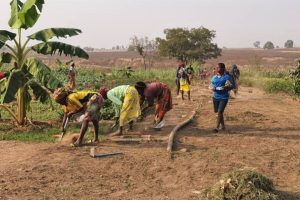How can photographers capture human connection in the age of coronavirus?
Venturing out onto the streets of New York City, photographer Ashley Gilbertson spotted a young woman standing under an alcove in the financial district. He stopped to watch as she poked her head out a few times before emerging with an elderly man on her arm. The woman — seemingly looking for a clear path — escorted the man, who was holding a white cane used by blind or visually impaired people, down the street and out of sight. The scene touched Gilberston, so he took a few photos. Under normal circumstances, it would be at this point that he would approach his subject to strike up conversation. But amid the coronavirus crisis and the need to practice social distancing, this simple social exchange was impossible. New York-based photographer Ashley Gilberston took this sequence in the city’s financial district in March. Credit: Ashley Gilbertson/VII/ReduxGilbertson said social distancing has dramatically chaged the way he interacts with his subjects. Credit: Ashley Gilbertson/VII/Redux”Not engaging with the people you’re photographing, for me, is the most difficult part of this whole thing,” said Gilberston over the phone from his home in New York. “I’m used to taking a couple pictures, then I introduce myself and say who I am, what I’m shooting for, and ask their name, where are they from, what are they doing, how are they feeling … So that part of my work has changed dramatically,” he said. Like many photographers around the world, Gilberston is facing up to the many ways in which the global pandemic has impacted his work. “Not engaging with the people you’re photographing, for me, is the most difficult part of this whole thing.”Ashley GilberstonFor some photographers, personal safety and the fear of contributing to the virus’ spread is real. For other freelancers, the harsh and immediate reality of losing their income, at least temporarily, is also extremely worrying. London-based photographer Suzanne Plunkett took this photo of her friend’s daughter while she attended an online ballet lesson during the lockdown. Credit: Suzanne PlunkettAbove these important practical concerns looms more philosophical questions: How does a photographer document one of the most significant shared human experiences in our recent history when, all over the world, streets are empty and people are in hiding at home? How can photographers reflect human connections when we must all keep our distance? Last month, James Wrigley, co-director of the photography platform Public Source, launched a website called the Covid-19 Archive. He and Jonathan Tomlinson, both of whom are based in the north of England, began building a digital archive of images relating to life in the time of the coronavirus. They’ve received submissions from over 30 photographers from around the world so far. Photographer Joe Habben took this photo on on February 23, the day that the Carnevale was cancelled in Venice, Italy due to the coronavirus outbreak. According to Habben, shops around the city quickly went from selling Venetian masks to anti-viral masks. Credit: Joe Habben/Public Source”This is the biggest thing to happen in our generation,” Wrigley said during a phone interview. “We wanted to create something that, in a few years, could act as a retrospective for this event.”As the virus spreads from country to country, more photographers have been drawn into the fast-moving story. Each experience is different. Jeremy Cheung, in Hong Kong, documented the first wave of the virus outbreak in the city in January, and is now witnessing a second phase of the crisis after a recent spike in new cases. “I’m using creativity as a relief and finding beauty as a tool to lift the weight off my mind.”Camilla FerrariHaving lived through the SARS outbreak 17 years ago, he said many of the city’s inhabitants were initially quick to respond to Covid-19. In an email interview he pointed to a sense of solidarity felt across the city as everyone went into “fighting mode,” having learned from past experiences. Photographer Jeremy Cheung took this photo of a Hong Kong woman against a large supply of toilet paper on sale in February. Credit: Jeremy CheungDuring this new wave of infections in Hong Kong, Cheung said that he tries to shoot with a long lens, but he’s not going out much right now. “I do not shoot on the streets too often now as I am trying my best to be a responsible civilian (by staying at home),” he said. At home, some photographers have turned their cameras on themselves and their families as they live through lockdowns together. Many are using their craft to seek out ways to show what life is like, while also trying to make sense of the situation or distract themselves from reality. Of this self portrait, Camilla Ferrari wrote, “In steam clouds after having a shower. As the days go by, I increasingly feel the need to pay more attention to my way of clothing in the house and my self care, as I would if I needed to go out and work.” Credit: Camilla FerrariCamilla Ferarri took this photo on day 10 of the lockdown in Milan on March 19. She called it, “Clothes dry under the sun.” Credit: Camilla Ferrari”I’m using creativity as a relief and finding beauty as a tool to lift the weight off my mind,” wrote Camilla Ferrari in an email, who recently spent 15 days at home in total self-quarantine in Milan. The photographer said she turned her attention to her her partner and “the simplicity of everyday life,” by exploring “the core of the home and the feeling of home and hoping that someone else will relate to what they see.” “It’s not so much about the pandemic, it’s about emerging behaviors across towns, cities and borders”James Wrigley Gail Albert Halaban is already known for photographing people at home. Taken through the windows of onlooking neighbors, her voyeuristic images show people at home in a semi-staged setting in cities around the world long before the outbreak of coronavirus. Now, the pictures feel eerily relevant. Speaking from her apartment in New York she said, “I think that the window space is the place where we do make so much of our connections, particularly living in a city.Gail Albert Halaban, took this photo titled, “Reunion after Days Away,” in Lucca, Italy before the coronavirus outbreak. The photo is published in her book “Italian Views.” (Aperture, 2019) Credit: Gail Albert Halaban”If you look across into your neighbors’ window, you see that they’re doing the same things you’re doing … in our social isolation, it’s really reassuring to see that the person across the street is also homeschooling or making their coffee or reading bedtime stories.”For Halaban, photography’s power comes from its ability to ground us in a moment in time. “I think photography is the most present medium,” she said, “It’s saying, ‘I am here now and I’m making this picture and it only exists in this instantaneous moment in time.'”While vast swathes of society must stay at home for our own protection, limiting physical contact in unprecedented ways, photographers can still capture human connections and symbolic moments in time. Bruno Taveira took this photo in Cascais, Portugal. Of the photo he wrote, “Many people turn to supermarkets to buy essential goods, after the Portuguese government decreed a state of emergency.” Credit: Bruno Taveira/Public Source”It’s not so much about the pandemic,” said Wrigley, “it’s about emerging behaviors across towns, cities and borders.”Portraits of families taken through windows, still-life shots of the many meals had at home, light as it reflects through houses around the world; this repetition of imagery begins to build a simple, shared narrative of many living through this time, away from each other, but somehow together. “It just shows we’re all in the same boat,” Wrigley concluded. ______Top photo credit: Ashley Gilbertson/The New York Times/ReduxPhoto Editor: Sarah Tilotta







